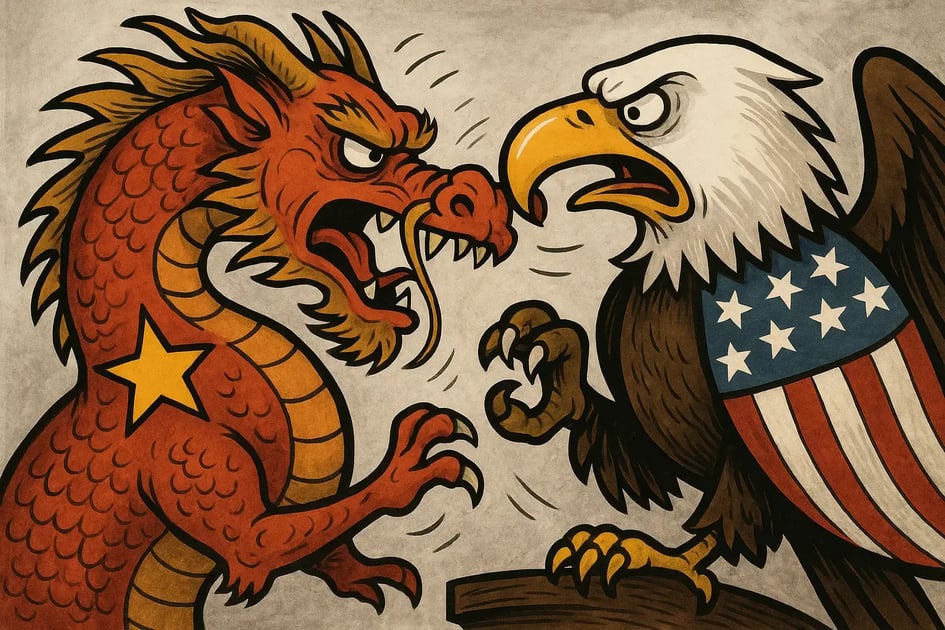Rising Trade Tensions Between 2 Super Powers
April 24, 2025 •Christian Lee

The markets remain extremely volatile, largely because of US tariff policies. The trade dispute between the US and China has entered a new phase, with both countries raising tariffs against each other - the US up to 145% and China up to 125%.
While some technology products have been exempted from these tariffs, providing temporary relief, overall trade between countries continues to face significant challenges. With the world's two largest economies in conflict, what does this mean for both the global economy and investors?
Further escalation
The US-China trade fight has gotten much worse, with tariffs reaching extreme levels. The US now charges up to 145% extra on Chinese products, while China hits back with 125% tariffs. Though trade won't completely stop between the countries, the disruption could be major. Companies are already finding ways around these challenges by shipping goods through other countries and using available exemptions.
One important exemption came on April 11, when the US temporarily excluded important tech products like smartphones, computers, and chip-making equipment from the latest round of tariffs. This seemed to give supply chains a short break. However, over the weekend, President Trump suggested these products might face a separate "semiconductor tariff" instead, making the situation for electronics trade even more confusing.
China's exports grew by 12.4% compared to last year's March, which was much better than expected. This growth happened mainly because companies rushed to ship goods before the tariffs took effect. While this might help China's first-quarter GDP, trade is expected to slow down significantly in the coming months.
There's a serious risk that China's economic growth in 2025 (currently predicted at 4.2%) could be much lower, especially if the government doesn't provide substantial financial support.
Neither country seems ready to back down, though China has indicated it won't raise tariffs further for now. Both sides appear to be using more subtle tactics - like exemptions, reclassifying products, and routing goods through third countries. All this creates continued uncertainty about future trade.
Selected exemptions add more confusion
Over the weekend, investors were once again surprised by the US Customs and Border Protection agency’s announcement to exempt certain original equipment manufacturers from tariffs.
Those providing smartphones, PCs/notebooks, and other consumer electronic devices are currently exempt from the 145% tariff regime imposed on China by the US government.
This change resulted in turmoil in the global technology space. Software stocks over hardware seem to be the preferred asset class to be overweight in, semiconductor, and equipment providers in the longer term, but would not exclude increased volatility in the overall technology space in the near term.
A divorce between USA and China
Most market experts believe that trade tensions between the US and China have reached their highest point, since both countries have stated they don't plan to increase tariffs further.
The Hang Seng Index (Hong Kong's stock market) has started to recover. However, when US Treasury Secretary Scott Bessent was asked about possibly removing Chinese companies from US stock exchanges, he responded that "all options are on the table."
This comment brought this risk back into focus for investors. Chinese ADRs (American Depository Receipts) allow US investors to buy shares in Chinese companies that aren't directly listed on US stock exchanges. These ADRs are issued by US banks and represent shares in Chinese companies, making it possible to trade them on US exchanges. If Chinese ADRs were delisted, it would create major problems for investors.
While we can't predict whether the US will actually move forward with delisting Chinese companies in the coming months or this year, it does seem that President Trump plans to push for some level of financial separation between the US and China during his second term in office.
**********
Like what you read? Share this article with your network by clicking on the Share buttons below.
You may also be interested in these articles:
- The Future of Fish Farming
- Changing The World With Carbon Tax
- What is The 2030 Agenda for Sustainable Development?
- Decarbonizing Real Estate
Disclaimer: The views and opinions expressed in this article are those of the author and do not necessarily reflect the official policy or position of Maiden Capital. The information provided is meant as a general guide only and should not be construed as investment advice. You should always consult your financial, legal and tax advisers regarding private equity and real estate investments
